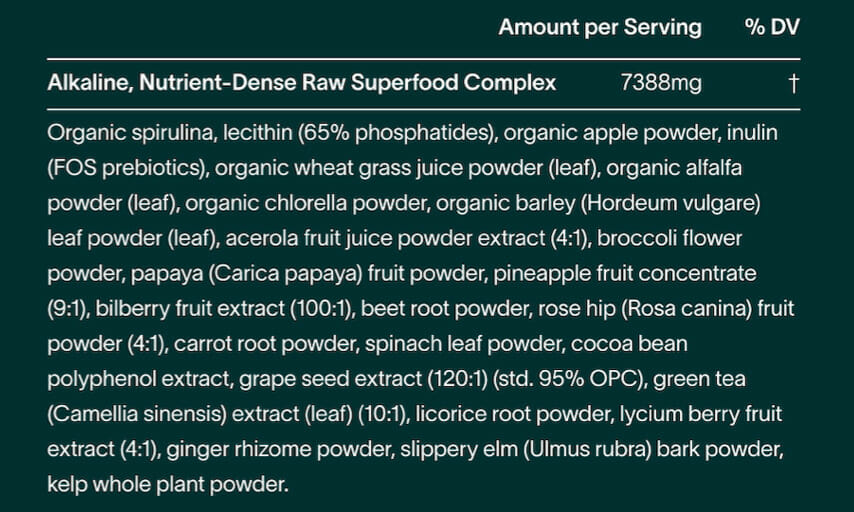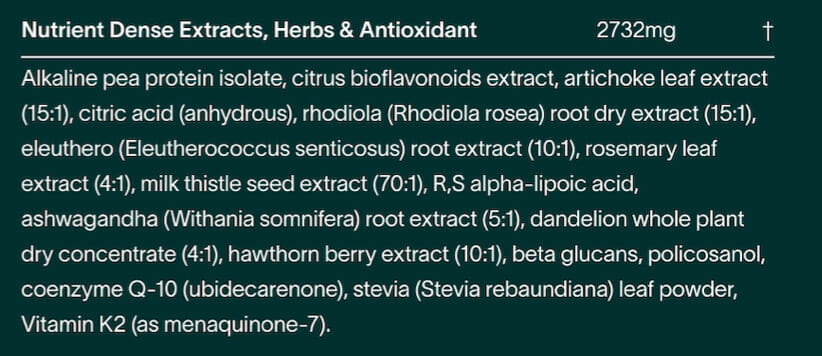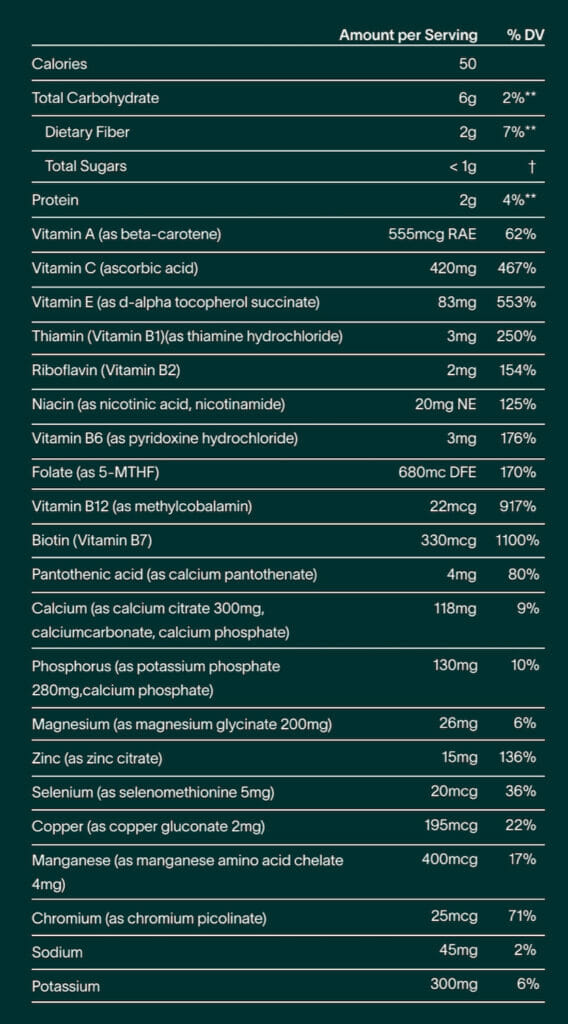
AG1, previously known as Athletic Greens, is a whole food dietary supplement designed to fill the “nutritional gaps” found in most of our diets.
And let’s be real, the use of the term “nutritional gap” is a monster of an understatement – if AG1 wanted to be more accurate they could’ve used “nutritional chasm” instead.
Regardless, AG1 is a kind of all-in-one supplement that combines 75 different whole food-sourced ingredients into one easy to use mix.
Simply mix a scoop of AG1 with a full glass of cold water (the included water bottle and metal scoop even make this remarkably easy) and off ya go.
Nutritional highlights include loads of vitamins and minerals, both pre- & probiotics, phytonutrients, adaptogens (mushroom mix), and a bunch of other whole food derived goodies.
And considering each serving of AG1 is only 50 calories and free of all major allergens, it should be compatible with most diets.
The biggest downside I see to using AG1 is the cost – at roughly $80/month, this stuff isn’t cheap.
There’s also the whole issue that there really isn’t any research to show that taking supplements in general really improve overall health.
But if you’re going to give supplementation a try, AG1 is likely one of the best options in its class.
In this review, I’ll go over everything you should know about this popular supplement, including the important stuff like how it actually tastes.
After reading, you’ll be able to decide for yourself whether or not it’s worth trying.
Disclaimer- the good people at AG1 were kind enough to send me a sample to try out for this review, but I haven’t been compensated in any other way. This review is based solely on my experience with AG1. That said, as an affiliate, I do get paid a small commission if you decide to make a purchase through any links in this article.
The AG1 Nutritional Supplement
AG1 has been around for a long time.
The first formula, previously known as Athletic Greens, started around 2010, making it one of the first all-in-one nutritional powders to hit the market.
That said, it wasn’t until more recently that I started seeing commercials for it, coinciding with their brand name change to “AG1”.
I’m assuming they changed their name to help promote that their product isn’t just for serious athletes – either way, I do agree “AG1” rolls off the tongue a little easier than “Athletic Greens”.
As I’m writing this, AG1 really only sells the one product we’re here to talk about now, so they haven’t branched out to expand their lineup much.
Personally, I kinda like this because it shows they’re focusing on doing what they do to the best of the abilities.
Anyway, let’s get this show going.
There’s a lot going on in AG1, so I think it makes sense to start off by talking about what’s actually in it; then I’ll go over key nutritional stats, how it tastes, and cost.
But before I do, I want to say that it’s a good idea to check with your doctor before starting any new supplements – especially if you’re taking any prescription meds, pregnant, breastfeeding, or dealing with any other medical issues.
Pros
- Lots of whole food ingredients
- Tons of vitamins and minerals
- Adaptogens
- Prebiotics
- Probiotics
- Low calorie
- Low sugar
- Free of most allergens
- Compatible with most diets
- Decent taste
- Nice starter kit
- Mixes well
Cons
- Expensive
- Only 2g of protein
- Only 2g of fiber
Ingredients
AG1 boasts that they use 75 different vitamins, minerals, etc. in their powder and when you stop and look at the ingredient list, it looks like they’re telling the truth.
There are a ton of ingredients in this stuff.
I’m not going to bore you (or destroy my fingers) by typing every single ingredient out here because you can easily check ’em for yourself, but I do want to go over the broad strokes of what AG1 is using here.
Raw Superfood Complex

Around 25 of the listed ingredients fall in the superfood complex and these include a lot of different fruit and vegetable powders and extracts.
Assuming these ingredients are listed in order of concentration (although we have no idea how much of each ingredient is actually in these blends), it looks like spirulina is the most abundant of the superfood powders in AG1.
Spirulina is a type of algae that’s commonly found in these nutritional supplements and it boasts a lot of possible health benefits.
These include anti-inflammatory and antioxidant properties, as well as being loaded with plenty of vitamins and minerals.
There’s also inulin, a type of fiber found in plants, that acts as a prebiotic (meaning out digestive system can’t break it down, so it makes it all the way to the bacteria in our intestines where they can feast on it).
Inulin likely the most popular prebiotic being used now and this is what I’m assuming is accepting for the majority of fiber found in AG1.
There’s also green tea leaf extract – green tea is loaded with antioxidants and supposed to be like the healthiest of all the teas.
The rest are various fruit and vegetable powders, some of which are organic and many that aren’t.
Speaking of which, given the price, I’d like to see nothing but organic ingredients, but maybe it’s too challenging to find some of these in organic form?
Extracts, Herbs, & Antioxidants

Another 16 or so ingredients fall in this category, which includes a few heavy-hitters in the nutritional world.
Pea protein is a popular plant source of protein, containing all 9 essential amino acids (“essential” meaning our bodies can’t create ’em, so we have to get these amino acids from our diet), but with only 2g of protein per serving, there can’t be too much of this in the mix.
The above list mentions a lot of different antioxidants, which are important components for protecting us from the damage free radicals can cause.
Antioxidants are important for proper immune function, but they may help protect us from a whole host of bad things, including heart disease and cancer.
You’ll also notice there’s some stevia powder in there – stevia is a popular all-natural sweetener that’s calorie-free and isn’t supposed to raise blood glucose levels.
Digestive Enzymes & Mushrooms

This category includes mushrooms and herbs known for their abilities to help with digestion, immune function, and cognitive health.
These also include adaptogens (astragalus, burdock root, reishi) which have become increasingly popular in recent years for their proposed abilities to help our bodies handle the stresses of daily life.
These ingredients can supposedly help with immune, hormonal, and neural function, but again – there really isn’t much evidence to show that using these supplements offers any real health benefits.
Dairy-Free Probiotics

Probiotics are live bacteria that may be able to help promote improved digestion by improving the overall state of our microbiome.
There’s a lot of research going on these days regarding the role our microbiomes play in overall health and it looks like these tiny little organisms play huge roles in our well-being.
Many believe improving our microbiome can help our abilities to digest and absorb nutrients, but may even be able to help with things like allergies, skin conditions, and more.
By the way, it’s possible that all the processed foods and junk we eat are starving our microbiome, causing a lot of our health-related issues to begin with…
Anyway, as far as I’m aware, there isn’t really any good research showing that consuming probiotic supplements have shown to be especially helpful, but they’re generally considered to be safe.
So, it probably can’t hurt.
The 2 probiotics mentioned above commonly found in probiotic supplements.
Nutritional Stats

Ok, so there’s a lot of different vitamins, minerals, antioxidants, and other good stuff in AG1, but let’s take a quick look at the nutritional stats all those ingredients combine to provide.
You can see all the specifics above, but I want to make a few observations.
For starters, at only 50 calories, AG1 is very low-calorie – regardless of what diet or routine you’re on, I can’t imagine adding an extra 50 calories per day is going to throw you off.
And with less than 1 g of sugar, this is also a low-sugar product, so folks keeping a close eye on their carbs should be fine too.
There’s also only 2 g of protein and 2 g of fiber, both of which are a bit low.
Personally, I’d like to see more of each, especially the fiber.
According to WebMd, most of us would benefit from eating 3 – 5g of prebiotic fiber daily for optimal gut health – so, at only 2 g, AG1 falls a bit short of the daily recommendation.
Looking at the vitamin profile, you’ll notice that AG1 has a lot of Vitamin C, Vitamin E, and high amounts of all the B-Vitamins.
FYI, these are the same B-Vitamins that are known for playing a big role in cellular metabolism and improving overall energy levels.
This is likely the reason why some users notice improved energy while using AG1.
It also has a fair amount of zinc, a mineral that helps with immune function, metabolism, and other bodily functions.
If we’re comparing AG1 to a traditional multi-vitamin, it would score highly with its Vitamin C and B-Vitamin profile, but it would fall a little short with its mineral content.
Most notably, you’ll notice that it doesn’t have any iron or Vitamin D, both of which are probably lacking in most of our diets.
And I would think most people considering using AG1 want this to be the only supplement they want to take each day.
Overall though, AG1 is a low calorie, low sugar supplement that’s a good source of several vitamins and minerals, but it would be nice if it also contained iron and Vitamin D.
Taste
We’ve gone over all the objective stuff that’s in AG1 and I offered my take on what’s in this supplement, but let’s get to what really matters – the taste.
I’ve tried a lot of supplements and whatnots over the years and one thing I know for sure is that if something doesn’t taste good, it’s unlikely you’ll be able to keep using it for the long run.
Trust me – it doesn’t matter how healthy it is or how good it makes you feel, if it tastes gross, you’ll eventually stop.
Luckily, I don’t think AG1 tastes gross.
I’m not sure I’d exactly say it tastes good, but certainly not gross.
AG1 comes as a fine green powder that’s designed to be mixed with a full glass (8-12 oz) of cold water and when you first open the pouch, the smell of sweetness hits ya first.
Based on the smell, I was expecting an overly-sweet taste (similar to that of the Early Bird Cocktail), but I was pleasantly surprised to find that it doesn’t taste as sweet as it smells.
I find AG1 to be subtly-sweet with a mild pineapply (that’s probably not a word) flavor.
Which makes sense, considering there’s pineapple fruit powder in the mix (as well as stevia).
In terms of overall flavor, on a scale of 0-10, I’d give AG1 a solid 7 – not something I’d especially look forward to, but still very drinkable.
It also mixes well with water.
The fine powder is easy to mix with a spoon, but it would work well in a mixer-bottle or blended in a smoothie too.
Speaking of which, I could see AG1 working very well when added to a fruit smoothie – the subtle pineapple flavor should pair nicely with bananas, strawberries, or pineapple of course.
Cost
As I’m writing this, AG1 can be purchased as either a 30 day supply pouch or 30 individual travel pack servings. These cost the following:
- 30 day pouch (with monthly subscription): $79
- 30 day pouch one time purchase: $99
- 30 day travel pack servings (with monthly subscription): $89
- 30 day travel pack servings one time purchase: $109
So, if AG1 was sounding great up to this point, this is likely going to be the biggest concern for most would-be customers.
There’s no getting around the fact that AG1 is pricey.
$80/month for supplementation may be more than what a lot of people are looking to spend.
But let’s take a minute and break that price down a little more to see how it stacks up against the competition.
If we ignore all the whole food based ingredients and simply think of AG1 in terms of vitamins, minerals, and -biotics, we can compare prices to other products.
So, if you wanted to save some money, you could replace AG1 with a multi-vitamin and a prebiotic/probiotic supplement.
You can get a month’s supply of a quality multi-vitamin for like $10 and a pre-/probiotic for around $20, give or take.
Oh wait, I forgot about the adaptogens in AG1…
An adaptogen supplement bought separately is probably another $20/month.
So, adding this up, taking these 3 supplements individually would likely cost ya somewhere around $50/month – and even though you wouldn’t be getting the whole food sources, you could save some solid cash.
Not to say taking pills offers the same benefit as ingesting powders, but based on the research we don’t really know (we don’t really know whether using any of these supplements offers that much health benefits, but that’s the same for any supplement).
Anyway, it’s probably not that fair to compare AG1 to taking pills, so let’s take a look at some of the other daily nutrition supplements out there.
For the sake of comparison, we’ll use price/serving, which for AG1 is $2.63 (for pouch subscription).
There are plenty of similar “daily green” powders out there and examples include Huel ($1.50/serving), Enso ($1.33/serving), and Laird ($1.60/serving).
I’m not saying any of these powders are of the same quality as AG1, but based on these comps, it would seem AG1 is priced a little high.
That said, Ka’Chava, which I personally like quite a bit, is priced at $3.99/serving (although to be fair, that’s designed as a meal replacement protein shake, so it’s a little different).
Overall, when it comes to total price, AG1 is one of the more expensive options out there.
Oh, I’d like to give AG1 a shout out for how awesome their starter pack is though – it comes with a metal canister for holding the powder, a shaker bottle, 5 samples of the travel packs, and a metal scooper spoon.
Very cool.
I also got a sample of their vitamin-d3 supplement, but I’m not sure if that normally comes in their starter pack or not.
Final Thoughts
Ok, that’s about all I got when it comes to AG1.
I’d like to thank AG1 again for allowing me to sample their product and I’d like to mention once again how nice the starter pack is (it’s also professionally packaged, so I could see it working well as a gift for someone else).
When you take a look at all the good stuff used to make this powder, it’s hard to deny that AG1 is about as comprehensive as any daily nutrition supplement out there.
Having all your vitamins, minerals, pre-probiotics, and adaptogens in a single supplement certainly makes it easy to include these in your daily routine.
The biggest downside I see, other than the price, is that it doesn’t have any Vitamin D or iron and it’s a bit low in protein and fiber content.
But it doesn’t taste bad and it’s easy to mix, qualities that go far for a supplement like this.
It’s also really easy to travel with, something that could come in handy for folks struggling to get out of the house in time in the mornings.
It’s hard to answer whether or not this powder is worth the higher cost because that really depends on what you’re looking for from your supplements.
If you’re looking for quality ingredients from a trusted brand, AG1 is probably worth the higher price.
After all, you know what they say about getting what you pay for.



